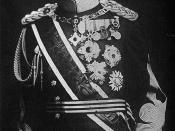Introduction
The emergence of a single imperial line in Japan probably dates from the 6th century AD, if not earlier. By the 7th century, the country was unified as an empire modeled largely on the Chinese state. Over subsequent centuries, however, the emperor's control declined and local feudal lords, served by the samurai warrior class, began to hold the real power. In 1192 Minamoto Yoritomo became shogun, or military governor, and the shoguns were in effect Japan's rulers until 1867.
As the European powers began to seek trade and colonies in Asia, the Tokugawa shoguns (1603-1867) tried to preserve Japan's culture by banning Christianity, expelling foreigners, ending almost all trade and even forbidding Japanese to leave the islands. In 1853 and 1854 an American commodore, Matthew Perry, arrived with a small fleet and--with the implicit threat of attack--forced Japan to open to trade and establish diplomatic relations. The shogun was humiliated, and in 1868 dissident samurai established a new government under the era name Meiji, in which power was ostensibly restored to the emperor.
Under the Meiji emperor, who ruled until 1912, Japan's leaders sought to modernize Japan by abolishing feudalism and overseeing the creation of a modern military and a directly elected house of representatives. With the reforms, Japan gathered strength both at home and abroad, surprising the world by defeating China (1894-95) and Russia (1904-05) in wars and gaining new colonies in Taiwan and Korea. Japan began to see itself as the natural master of Asia, guided by a divine emperor.
In the 1920s, under moderate political leaders, Japan concentrated on economic, rather than military, expansion. But worldwide depression in the 1930s saw the rise of a right-wing, ultra-nationalist militarist faction, culminating in the election of General Hideki Tojo as prime minister in 1941. Under this group, which...


